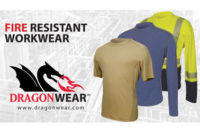When specifying FR garments for your company, keep the following in mind:
1. Garments should fit properly without significant modification.
While it may be tempting for some women to roll up their sleeves on a larger garment for a better fit, this is not an option with FR apparel due to safety hazards. When women wear unisex – or worse – men’s FR garments, personal modifications are often required but nonetheless increase the likelihood of an accident in the workplace. For example, oversized clothing can get caught in machinery or cause workers to trip and fall.
| Cold Weather Dos and Don’ts |
|
Dressing to work in cold weather can be more complex than putting on a heavy coat and heading out to the site. Workers who perform physical skills outdoors must pay special attention to multiple factors that affect their sense of comfort and their safety, including: • Temperature and humidity of the environment • Level of physical activity • Size, weight and physical condition of the worker Over time, workers acclimate to environments and physical activity levels, and can adjust their clothing accordingly. For cool temperatures, matching the right fabric technology and layers to the daily tasks of a worker is critical. A man and a woman who are at the same site may need completely different uniforms based on their activity, role, work cycle and physical build. It is also essential to select only FR layers. Incorporating garments that are not FR – especially heavy weight versions – can lead to additional fuel for a fire. For example, when wearing a non-FR hoodie underneath an FR shirt, the exposed non-FR hood is dangerous and non-compliant with FR standards. This can be especially dangerous if a female worker is already wearing oversized or poorly fitting garments. Additionally, many outdoor specialty winter base layers are made from polypropylene and blends that contain polyester. These materials have low melting points and can potentially lead to tragic injuries if exposed to a thermal incident, even if they are underneath an outer FR layer. When developing your winter weather uniform choices, consider garments that allow maximum protection and flexibility for your team, including considerations for both male and female workers. The more your employees can customize their uniforms using layers, the more likely they will remain compliant. |
You can potentially avoid these issues by selecting women’s FR garments that are designed in a range of sizes to accommodate different female body types. Make extra-small to plus size options available and have all employees try on garments to ensure they fit.
• Shirtsleeves should be short enough that they do not need be rolled or cuffed.
• Shirttails should be long enough that they can be tucked in, but short enough in the body to eliminate bunching when tucked into pants.
• Coveralls should be fitted for a woman’s hip and waist sizes so excess fabric does not get caught on equipment handles or affect mobility.
• In addition to the sleeve and pant-length, the body of coverall garments should fit the wearer.
• Shirts with adjustable cuffs help keep shirtsleeves from riding up, which is helpful with varying wrist sizes.
2. Safety and comfort go hand-in-hand.
Discomfort can be distracting in the workplace, as an uncomfortable worker may be more focused on their clothing than their job. Misfit uniforms can also preclude workers from being able to perform essential tasks, such as bending, lifting or moving fluidly.
Garment fit goes beyond just size and cut. Temperature should also be a key consideration for ensuring comfort. A recent study2 found FR garment wearers consider light weight and breathability two of the most important aspects of comfort in FR garments.
• Fabric quality and traits of the FR garment should be examined to ensure it is engineered for moisture-wicking and breathability. This is important for all seasons.
• Garments in which the FR technology is inherent (woven into the fabric) eliminate heavy FR coatings that could make the garment uncomfortable or stiff.
• Specific instructions for extreme temperatures should be outlined to avoid any confusion. Hot conditions should not permit rolled-up sleeves, whereas cold temperatures should not introduce non-FR hoodies or other flammable street wear.
3. An Equilibrium in FR Wear.
Today’s FR garment programs must include options for women that align with the garments selected for men to maintain uniformity. Women’s garments may differ from men’s in the sizing, cut and small details like button dimensions, but ensuring that logos, colors and styles remain consistent on all garments creates brand uniformity in the workplace.
A women’s FR program is about equipping female employees with the right tools to help improve performance, comfort and safety on the job.
References
1 Bureau of Labor Statistics Infographic – Bureau of Labor Statistics. 2014.
2 FR Market Research Study – Bainbridge Strategy Consulting. June 2014.


